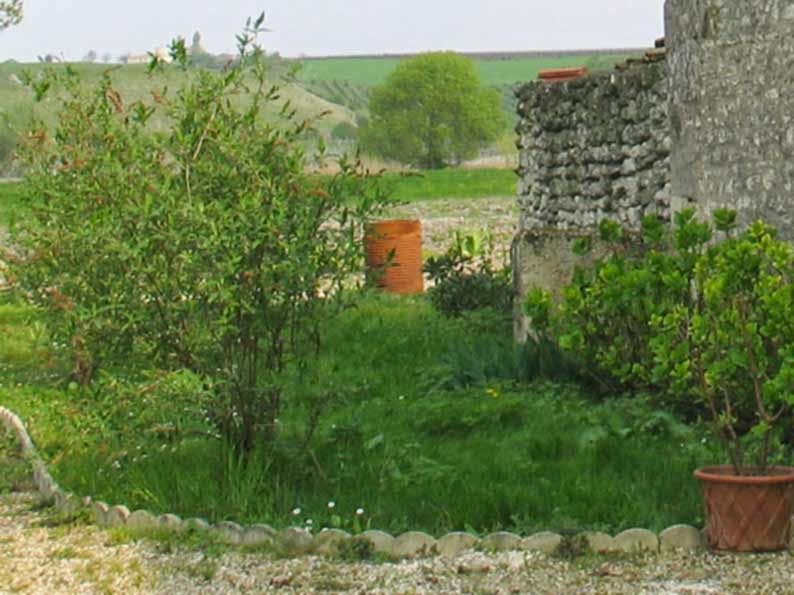"None can have a healthy love for flowers
unless he loves the wild ones" - Forbes Watson
 |
| A garden opening onto the marais |
All this wet weather is certainly good for one thing: blossom! Blackthorn in particular seems to have outdone itself this year and the salt marshes are bounded by many hedgerows such as this one. (It makes up for the sad fact that other field hedges have been ripped out by local farmers seeking to maximise their yields.)
 |
| Pussy willow or Salix |
Willows have also provided a host of catkins this spring and out on the marais we passed this beautiful "sallow" tree which, unusually, was not part of a hedgerow.
Sallows have fluffy catkins, or flowers, that are held almost erect rather than drooping down; these are the pussy willows which are often used to decorate churches on Palm Sunday.
Spring arrivals
 |
| Birdwatching along the estuary |
At this time of year, the Gironde Estuary is a good source of birdlife as there's a mixture of habitats along its banks and no shortage of water!
In the past ten days, we've seen both hoopoes and swallows arrive on our shores whilst we were busy chasing elusive penduline tits (see my last post).
 |
| A well-earned rest! |
We usually record the first swallow in mid- March but this one was photographed on the 21st, which might indicate they were a bit late arriving. On the other hand, we might simply have missed the early birds... Christina acts as chief 'spotter' striding out in front, whilst I bring up the rear with my camera, often trying to focus on a moving target.
 |
| Celastrina argiolus |
On a brighter morning, we spied another harbinger of spring - a blue butterfly which I think is the Holly Blue, even though it was soaking up sun on a bay leaf.
Whilst holly is quite a rarity down here, bay trees are ubiquitous: very tough and fast growing, they are best avoided in the garden. (Their small, culinary cousin is absolutely fine however.)
Whilst holly is quite a rarity down here, bay trees are ubiquitous: very tough and fast growing, they are best avoided in the garden. (Their small, culinary cousin is absolutely fine however.)
This butterfly was spotted on the edge of some woodland which borders a vineyard and provides another fertile habitat for birds and insects.
 |
| Sloes (blackthorn) blossoming at the woodland edge |
Meanwhile, back in our garden we've enjoyed watching the first blossoms on our small peach tree unfurl their petals.
 |
| Prunus persica |
We grew this from a stone a couple of years ago and, much as I love most types of Prunus, I wasn't particularly keen to plant this one in our garden. This is mainly due to the fact that it needs spraying now in order to prevent unsightly leaf-curl later on.
Christina, however, is not so squeamish when it comes to wielding the Bordeaux mix (copper sulphate) which is what our neighbours seem to use, and she gave the tree a couple of preventative sprays on those rare days when the wind wasn't blowing.
Colour after the crocuses have gone...
 |
| Chionodoxa forbesii "Pink Giant" |
This pretty little bulb produces starry pink-to-lavender flowers which are reminiscent of a hyacinth, with similar fleshy leaves.
It originally came from the mountains of western Turkey and there are varieties from other areas with bright blue flowers which would also be worth having. They bloom early in the year and soon get covered by plants such as forget-me-not, so foliage die-down is not a problem.
Another exquisite early bulb is this tiny tulip with multiple heads and arched stems which gives it the appearance of a lily.
Once those petals open, however, it turns into an attention-grabbing star with a distinctly sunny disposition! Planted last autumn, these clumps already seem well-established.
These species tulips come from Central Asia and I love the fact that they look wild and combine happily with other delicate plants, perhaps grown around the base of a fruit tree or in a rock garden.
Like most bulbs, they need good drainage and plenty of sun, so avoid putting them in areas which will require heavy watering in summer.
Other species worth having are Tulipa praestans (scarlet, flowering April) and Tulipa clusiana with grassy foliage (pink, streaked white, also flowering in April).
Although primroses are traditionally pale yellow when found in the wild, and we have several clumps planted under hedges, I deliberately grew some blue primulas from seed just to introduce another colour into the spring border.
These have been flowering for at least a couple of weeks now (in places where the birds haven't nibbled their buds!) and their petals seem to change from blue to violet depending on the light.
 |
| Tulipa turkestanica |
Once those petals open, however, it turns into an attention-grabbing star with a distinctly sunny disposition! Planted last autumn, these clumps already seem well-established.
 |
| T. turkestanica opening to sun |
Like most bulbs, they need good drainage and plenty of sun, so avoid putting them in areas which will require heavy watering in summer.
Other species worth having are Tulipa praestans (scarlet, flowering April) and Tulipa clusiana with grassy foliage (pink, streaked white, also flowering in April).
 |
These have been flowering for at least a couple of weeks now (in places where the birds haven't nibbled their buds!) and their petals seem to change from blue to violet depending on the light.
Before and After
 |
| Back garden in 2003 |
 |
| Bigger borders and less lawn in March 2015 |
 |
| Chalk cliffs surrounded by reed beds on the estuary |












